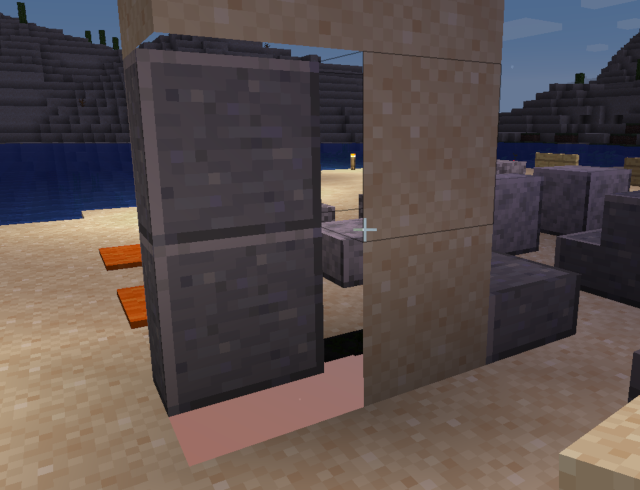This is an old revision of the document!
添加一个方块
将方块添加到你的模组过程与添加物品类似。你可以创建 Block 或自定义类的实例,然后将其注册到 Registries.BLOCK(1.19.3 以上版本)或 Registry.BLOCK (1.19.2 以下)注册表。你还需要提供纹理和方块状态或模型文件以提供方块外观。如需了解方块模型格式的更多信息,请参考Minecraft Wiki模型页面。
创建一个方块
首先创建Block的实例。该实例可以存储在任何地方,但是我们会在ModInitializer的顶部开始。Block构造器函数需要一个AbstractBlock.Settings实例,也就是用于配置方块属性的构造器。Fabric提供一个FabricBlockSettings构造器类以及更多可用的选项。
注册方块
方块应该注册在 Registries.BLOCK 注册表中。调用 Registry.register 并传递适当的参数。你可以直接在 onInitialize 方法中注册方块,也可以在静态部分创建方块实例时将其注册,因为 register 方法会返回这个方块实例自身。
如果你使用的是 1.19.2 以下的版本,请将 Registries.BLOCK 替换为 Registry.BLOCK。
您的方块不能作为物品存入背包,但可以通过使用 /setblock tutorial:example_block 在游戏中看到。
为方块注册物品
在大多数情况下,您希望能够拿着物品放置方块。为此,您需要在物品注册表中注册一个相应的物品。您可以通过在 Registries.ITEM 下注册 BlockItem 的实例来执行此操作。该物品的注册表名称通常应与该方块的注册表名称相同。
<code java [enable_line_numbers=“true”,highlight_lines_extra=“12”]>
public class ExampleMod implements ModInitializer {
public static final Block EXAMPLE_BLOCK = new Block(FabricBlockSettings.of(Material.METAL).strength(4.0f));
@Override
public void onInitialize() {
Registry.register(Registries.BLOCK, new Identifier(“tutorial”, “example_block”), EXAMPLE_BLOCK);
Registry.register(Registries.ITEM, new Identifier(“tutorial”, “example_block”), new BlockItem(EXAMPLE_BLOCK, new FabricItemSettings()));
}
}
</code>
===== 给您的方块一个外观 =====
您可能已经注意到,新的方块只是游戏中紫色和黑色棋盘格图案。这表明Minecraft加载方块资源或外观时出错。运行客户端时,完整的问题列表会输出在你的日志中。你需要以下文件来给予方块外观:
* 方块状态文件
* 方块模型文件
* 纹理
* 物品模型文件(如果方块有与之关联的物品)
这些文件位于:
方块状态:src/main/resources/assets/tutorial/blockstates/example_block.json
方块模型:src/main/resources/assets/tutorial/models/block/example_block.json
物品模型:src/main/resources/assets/tutorial/models/item/example_block.json
方块纹理:src/main/resources/assets/tutorial/textures/block/example_block.png
方块状态文件根据其方块装填确定该方块应使用的模型。由于我们的方块没有所谓状态,所以我们用空字符串表示所有:
<code JavaScript src/main/resources/assets/tutorial/blockstates/example_block.json>
{
“variants”: {
“”: { “model”: “tutorial:block/example_block” }
}
}
</code>
方块模型文件定义了方块的形状和纹理。我们将使用block/cube_all作为父模型,这将使我们能够轻松地在方块的所有面上设置相同的纹理。
<code JavaScript src/main/resources/assets/tutorial/models/block/example_block.json>
{
“parent”: “block/cube_all”,
“textures”: {
“all”: “tutorial:block/example_block”
}
}
</code>
在大多数情况下,您想让方块作为物品时外观还是这个方块。为此,您可以制作一个从方块模型文件继承的项目文件,这会使得该物品外观和方块相同:
<code JavaScript src/main/resources/assets/tutorial/models/item/example_block.json>
{
“parent”: “tutorial:block/example_block”
}
</code>
加载Minecraft,您的方块最终应该具有外观!
===== 配置方块掉落物 =====
该方块必须有一个战利品表,以便在该方块被破坏时掉落物品。以下文件会使方块被破坏时掉落其本身。
<code JavaScript src/main/resources/data/tutorial/loot_tables/blocks/example_block.json>
{
“type”: “minecraft:block”,
“pools”: [
{
“rolls”: 1,
“entries”: [
{
“type”: “minecraft:item”,
“name”: “tutorial:example_block”
}
],
“conditions”: [
{
“condition”: “minecraft:survives_explosion”
}
]
}
]
}
</code>
在1.17,破坏方块有所改变,定义采集工具和采集等级需要使用标签,请参考标签教程。我们需要将方块添加到以下标签:
采集工具:src/main/resources/data/minecraft/tags/blocks/mineable/<tooltype>.json,其中'tooltype'可以是'axe'、'pickaxe'、'shovel'、'hoe'
采集等级:src/main/resources/data/minecraft/tags/blocks/needs_<tier>_tool.json,其中'tier'可以是:'stone'、'iron'、'diamond'
<code JavaScript src/main/resources/data/minecraft/tags/blocks/mineable/pickaxe.json>
{
“replace”: false,
“values”: [
“example:example_block”
]
}
</code>
<code JavaScript src/main/resources/data/minecraft/tags/blocks/needs_stone_tool.json>
{
“replace”: false,
“values”: [
“example:example_block”
]
}
</code>
对于采集等级标签(needs_stone_tool、needs_iron_tool和needs_diamond_tool)生效,在方块定义中将requiresTool()到FabricToolSettings:
<code java [enable_line_numbers=“true”]>
public static final Block EXAMPLE_BLOCK = new ExampleBlock(FabricBlockSettings.of(Material.METAL).strength(4.0f).requiresTool());
</code>
===== 创建自定义方块类 =====
当创建一个简单的方块时,上述方法效果很好,但是有时您想要一个具有独一无二机制的方块。我们将创建一个单独的扩展Block的类来执行此操作。该类需要一个带有AbstractBlock.Settings参数的构造器:
<code java [enable_line_numbers=“true”]>
public class ExampleBlock extends Block {
public ExampleBlock(Settings settings) {
super(settings);
}
}
</code>
你可以在方块类中覆盖方法以实现特殊功能。这里是onUse方法的实现,右键单击方块时会调用此方法。我们检查交互是否在服务器进行,并向玩家发送消息,“Hello, world!”。
<code java [enable_line_numbers=“true”,highlight_lines_extra=“8,9,10,11,12,13,14,15”]>
public class ExampleBlock extends Block {
public ExampleBlock(Settings settings) {
super(settings);
}
@Override
public ActionResult onUse(BlockState state, World world, BlockPos pos, PlayerEntity player, Hand hand, BlockHitResult hit) {
if (!world.isClient) {
player.sendMessage(Text.of(“Hello, world!”), false);
}
return ActionResult.SUCCESS;
}
}
</code>
要使用自定义方块类,请在注册时将new Block替换为new ExampleBlock:
<code java [enable_line_numbers=“true”,highlight_lines_extra=“3”]>
public class ExampleMod implements ModInitializer {
public static final ExampleBlock EXAMPLE_BLOCK = new ExampleBlock(Block.Settings.of(Material.STONE).hardness(4.0f));
@Override
public void onInitialize() {
Registry.register(Registry.BLOCK, new Identifier(“tutorial”, “example_block”), EXAMPLE_BLOCK);
Registry.register(Registry.ITEM, new Identifier(“tutorial”, “example_block”), new BlockItem(EXAMPLE_BLOCK, new Item.Settings().group(ItemGroup.MISC)));
}
}
</code>
==== 自定义VoxelShape ====
当使用不能完整填充一个方块的方块模型(例如铁砧、台阶、楼梯)时,邻近的方块会隐藏面:
VoxelShape'':
 要解决这个问题,我们需要定义方块的
要解决这个问题,我们需要定义方块的
@Override
public VoxelShape getOutlineShape(BlockState state, BlockView view, BlockPos pos, ShapeContext context) {
return VoxelShapes.cuboid(0f, 0f, 0f, 1f, 1.0f, 0.5f);
}
注意方块的collision shape默认为其描边形状,如果未被指定。
下一步
给块一个方块实体,使它们可以具有物品栏之类的的高级状态。此外,还需要像GUI和自定义块渲染很多东西。

